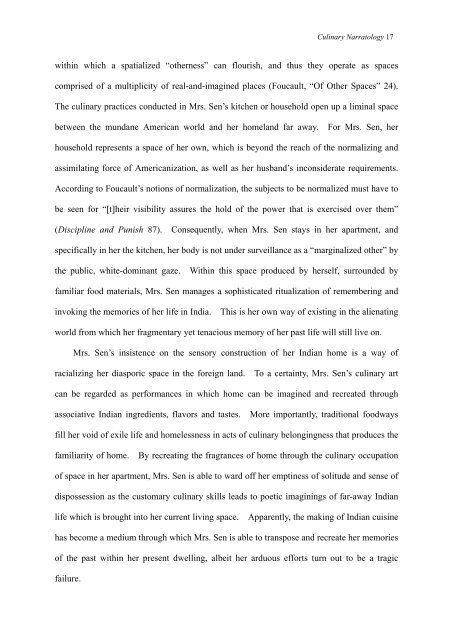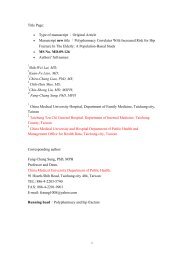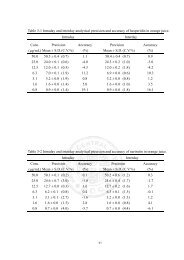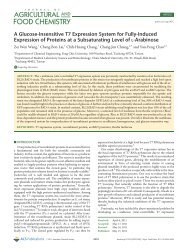Culinary Narratology in Everyday Life: Foodways and Identity ...
Culinary Narratology in Everyday Life: Foodways and Identity ...
Culinary Narratology in Everyday Life: Foodways and Identity ...
Create successful ePaper yourself
Turn your PDF publications into a flip-book with our unique Google optimized e-Paper software.
<strong>Cul<strong>in</strong>ary</strong> <strong>Narratology</strong> 17<br />
with<strong>in</strong> which a spatialized “otherness” can flourish, <strong>and</strong> thus they operate as spaces<br />
comprised of a multiplicity of real-<strong>and</strong>-imag<strong>in</strong>ed places (Foucault, “Of Other Spaces” 24).<br />
The cul<strong>in</strong>ary practices conducted <strong>in</strong> Mrs. Sen’s kitchen or household open up a lim<strong>in</strong>al space<br />
between the mundane American world <strong>and</strong> her homel<strong>and</strong> far away. For Mrs. Sen, her<br />
household represents a space of her own, which is beyond the reach of the normaliz<strong>in</strong>g <strong>and</strong><br />
assimilat<strong>in</strong>g force of Americanization, as well as her husb<strong>and</strong>’s <strong>in</strong>considerate requirements.<br />
Accord<strong>in</strong>g to Foucault’s notions of normalization, the subjects to be normalized must have to<br />
be seen for “[t]heir visibility assures the hold of the power that is exercised over them”<br />
(Discipl<strong>in</strong>e <strong>and</strong> Punish 87). Consequently, when Mrs. Sen stays <strong>in</strong> her apartment, <strong>and</strong><br />
specifically <strong>in</strong> her the kitchen, her body is not under surveillance as a “marg<strong>in</strong>alized other” by<br />
the public, white-dom<strong>in</strong>ant gaze. With<strong>in</strong> this space produced by herself, surrounded by<br />
familiar food materials, Mrs. Sen manages a sophisticated ritualization of remember<strong>in</strong>g <strong>and</strong><br />
<strong>in</strong>vok<strong>in</strong>g the memories of her life <strong>in</strong> India. This is her own way of exist<strong>in</strong>g <strong>in</strong> the alienat<strong>in</strong>g<br />
world from which her fragmentary yet tenacious memory of her past life will still live on.<br />
Mrs. Sen’s <strong>in</strong>sistence on the sensory construction of her Indian home is a way of<br />
racializ<strong>in</strong>g her diasporic space <strong>in</strong> the foreign l<strong>and</strong>. To a certa<strong>in</strong>ty, Mrs. Sen’s cul<strong>in</strong>ary art<br />
can be regarded as performances <strong>in</strong> which home can be imag<strong>in</strong>ed <strong>and</strong> recreated through<br />
associative Indian <strong>in</strong>gredients, flavors <strong>and</strong> tastes. More importantly, traditional foodways<br />
fill her void of exile life <strong>and</strong> homelessness <strong>in</strong> acts of cul<strong>in</strong>ary belong<strong>in</strong>gness that produces the<br />
familiarity of home. By recreat<strong>in</strong>g the fragrances of home through the cul<strong>in</strong>ary occupation<br />
of space <strong>in</strong> her apartment, Mrs. Sen is able to ward off her empt<strong>in</strong>ess of solitude <strong>and</strong> sense of<br />
dispossession as the customary cul<strong>in</strong>ary skills leads to poetic imag<strong>in</strong><strong>in</strong>gs of far-away Indian<br />
life which is brought <strong>in</strong>to her current liv<strong>in</strong>g space. Apparently, the mak<strong>in</strong>g of Indian cuis<strong>in</strong>e<br />
has become a medium through which Mrs. Sen is able to transpose <strong>and</strong> recreate her memories<br />
of the past with<strong>in</strong> her present dwell<strong>in</strong>g, albeit her arduous efforts turn out to be a tragic<br />
failure.









